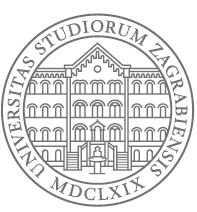Naslov Magnetska svojstva nekih polimernih nanokompozita Naslov (engleski) Magnetic properties of some polymer nanocomposites Autor Lucija Kisić Mentor Vladimir Dananić (mentor)Član povjerenstva Vladimir Dananić (predsjednik povjerenstva)Član povjerenstva Mirela Leskovac (član povjerenstva)Član povjerenstva Vesna Tomašić (član povjerenstva)Ustanova koja je dodijelila Sveučilište u Zagrebu Datum i država obrane 2019-10-29, Hrvatska Znanstveno / umjetničko PRIRODNE ZNANOSTI Sažetak Ovaj diplomski rad istražuje magnetska svojstva i utjecaj magneta na odabrane polimerne nanokompozite. Polimerni nanokompoziti dobiveni su postupkom u Brabender mješalici, te su obrađeni na dimenzije za daljnja ispitivanja magnetskih svojstva. Mjerenja su izvedena na uzorcima poliamida, poliamida sa ugljikovim nanočesticama, poliamida sa nanočesticama i COOH i poliamida sa dodatkom TiO2. Uzorci su mjereni dvjema eksperimentalnim tehinikama od kojih je jedna AC susceptibilnost metoda koja se izvodi na instrumentu koji se zove AC susceptometar, i koja je temeljna tehnika u istraživanjima magnetizma. AC metoda mjeri odziv u fazi s pobudom što nazivamo realna susceptibilnost, te nezavisno s njom mjeri i odziv izvan faze, što nazivamo imaginarna susceptibilnost. Imaginarna susceptibilnost služi kao mjera procesa disipacije energije u uzorku. AC susceptibilnost je široko rasprostranjena metoda za istraživanje fenomena magnetizma, svojstava magnetskih materijala i magnetskih efekata vezanih uz supravodljivost. U drugoj tehnici, mjerenja smo izvodili magnetometrom s vibrirajućim uzorkom (VSM). Uzorak je smješten na nosaču u prostoru izmedu polova magneta. Budući da je u polju magnetiziran i titra poznatom frekvencijom, u detekcijskim zavojnicama se zbog promjene magnetskog toka inducira električna struja te se analizira komponenta iste frekvencije. Iz rezultata vidimo da svako dodavanje drugih skupina sa nesparenim elektronima, jasno pokazuje utjecaj na magnetska svojstva materijala. Iz mjerenja dobivenih AC susceptometrom vidimo da dodatak COOH skupine uzoraku poliamida sa višeslojnim ugljikovim nanocijevčicama (MWCNT) doista zasjenjuje magnetizam, a sa povišenjem temperature da je to zasjenjenje manje. Stabilnost MWCNT uzorka se povećava sa dodatkom COOH, u usporedbi čistim sa MWCNT. Iz mjerenja dobivenih magnetometarom s vibrirajućim uzorkom (VSM) vidimo da su uzorci poliamida i poliamida sa TiO2 dijamagnetični sa malom količinom magnetske nečistoče u sebi, te da dodatak TiO2 smanjuje utjecaj tih nečistoča. Dodatak višeslojnih ugljikovihnanocijevčica (MWCNT) uzorku poliamida pojačava prijelaz oko 0. Kod poliamidnog uzorka sa višeslojnim ugljikovim nanocijevčicama i COOH , magnetsko polje usmjeravava nesparene elektrone od COOH. Vidimo da prisutnost funkcionalnih skupina (COOH) na bočnim zidovima CNT-a povećava kemijsku i fizičku reaktivnost između punila i matrice. Dodatak COOH mijenja prirodu površine CNT-a čineći ih kompatibilnijima s polimernom matricom.
Sažetak (engleski) This thesis investigates the magnetic properties and influence of magnets on selected polymer nanocomposites. The polymer nanocomposites were obtained by the process in a Brabender mixer and were dimensioned for further testing of the magnetic properties. Measurements were made on samples of polyamides, polyamides with carbon nanoparticles, polyamides with nanoparticles and COOH, and polyamides with TiO2 added. Samples were measured by two experimental techniques, one of which is AC susceptibility, a method performed on an instrument called an AC susceptometer, and which is a fundamental technique in magnetism studies. The AC method measures the phase response with an excitation of what we call real susceptibility, and independently measures the off- phase response, which we call imaginary susceptibility. Imaginary susceptibility serves as a measure of the energy dissipation process in a sample. AC susceptibility is a widespread method for investigating the phenomenon of magnetism, properties of magnetic materials, and magnetic effects related to superconductivity. In another technique, measurements were performed with a vibrating sample magnetometer (VSM). The sample is placed on a support in the space between the poles of the magnet. Since the oscillator is magnetized with a known frequency in the field, due to changes in the magnetic flux, electrical current is induced in the detection coils and a component of the same frequency is analyzed. From the results we can see that each addition of other groups with unpaired electrons clearly shows the influence on the magnetic properties of the material. From the measurements obtained with the AC susceptometer, we can see that the addition of the COOH group to the multilayer carbon nanotube (MWCNT) polyamide sample does indeed overshadow magnetism, and with the increase in temperature this shading is less. We conclude that the stability of the MWCNT sample increases with the addition of COOH, compared to the pure with MWCNT. From the measurements obtained with a vibrating sample magnetometer (VSM), we can see that polyamide and polyamide samples with TiO2 are diamagnetic with a small amount of magnetic impurity in themselves, and that the addition of TiO2 reduces the impact of these impurities. The addition of multilayer carbon nanotubes (MWCNTs) to the polyamide sample enhances the transition of about 0. For polyamide multilayer carbon nanotubes and COOH, the magnetic field directs unpaired electrons from COOH. We see that the presence of functional groups (COOH) on the lateral walls of the CNTs increases the chemical and physical reactivity between the filler and the matrix. The addition of COOH alters the nature of CNTs surface making them more compatible with the polymer matrix.
Ključne riječi
polimerni nanomompoziti
AC susceptometar metoda
VSM metoda
magnet
Ključne riječi (engleski)
polymer nano-composites
AC susceptometer method
VSM method
magnet
Jezik hrvatski URN:NBN urn:nbn:hr:149:065050 Studijski program Naziv: Ekoinženjerstvo Vrsta resursa Tekst Način izrade datoteke Izvorno digitalna Prava pristupa Zatvoreni pristup Uvjeti korištenja Repozitorij Repozitorij Fakulteta kemijskog inženjerstva i tehnologije Sveučilišta u Zagrebu Datum i vrijeme pohrane 2022-03-05 09:23:12


